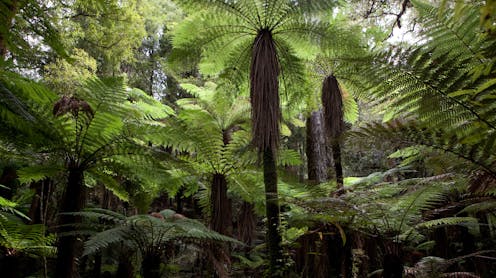Granting legal ‘personhood’ to nature is a growing movement – can it stem biodiversity loss?
- Written by Viktoria Kahui, Senior Lecturer in Environmental Economics, University of Otago

Biodiversity is declining at rates unprecedented in human history. This suggests the ways we currently use to manage our natural environment are failing.
One emerging concept focuses on giving legal rights to nature.
Many Indigenous peoples have long emphasised the intrinsic value of nature. In 1972, the late University of Southern California law professor Christopher Stone proposed what then seemed like a whimsical idea: to vest legal rights in natural objects to allow a shift from an anthropocentric to an intrinsic worldview.
Ecuador was the first country to enshrine rights of nature in its 2008 constitution. Since then, a growing number of countries have followed in awarding rights of nature.
This includes Aotearoa New Zealand, where legal personhood was granted to the Whanganui River, the former national park Te Urewera and soon the Taranaki maunga.
At its core, the rights-of-nature movement allows persons to take legal action on behalf of natural ecosystems, as opposed to on behalf of people affected by environmental degradation.
Ecosystems can become separate entities with their own agency, in the same way other non-human entities such as charitable trusts and organisations can exist as separate entities in law.
But can the movement help stem the loss of biodiversity? There is no easy answer. Our new research shows that many rights-of-nature examples have emerged because current systems were not enough to protect nature from continued economic pressure from development.
We find one of the key features of well designed rights-of-nature frameworks lies in defining who is ultimately liable, and what for.
Global case studies
The design of rights-of-nature frameworks varies widely in geography, legal status, guardianship and who holds liability.
We investigated 14 global rights-of-nature examples and categorised them by types of guardianship. For example, in 2008, Ecuador enshrined rights of nature in its constitution because of decades of pressure from large mining companies.
This represents a type of public guardianship where every citizen has the right to take legal action on behalf of nature.
In New Zealand on the other hand, the former national park Te Urewera was granted legal personhood with Tūhoe trustees as appointed guardians.
A legal person is defined as an entity which has the capacity to enter into contracts, incur debts, sue and be sued in its own right, and to be accountable for illegal activities. We define rights-of-nature cases with appointed guardians as “environmental legal personhoods”.
Read more: Rights for nature: How granting a river 'personhood' could help protect it
We then compared these cases to explore why they emerged and how they are designed. Who advocated on behalf of the environment? What was the exploiting activity putting pressure on the ecosystem? What is the liability status of the guardians?
We found that, overwhelmingly, Indigenous people and local communities acted as advocates. For example, the Whanganui River in New Zealand was granted legal personhood in 2017 as a result of hundreds of years of resistance by Indigenous Māori to aggressive colonisation.
Since 1848, the Crown has introduced a steamer service, cleared forest from river banks, extracted sand and gravel, and diverted water into a power scheme. This led to ongoing conflict with Whanganui iwi who raised concerns about the river’s health and the desire to preserve the resource for future generations.
Response to sustained economic pressure
On the other side of the world, the Mar Menor lagoon in Spain was declared a legal person in 2022 due to strong local community advocacy against pollution from agriculture, mining and sewage.
The evidence from our research points to a fundamental divide between local communities and external economic interests. The rights-of-nature movement has come as a response to sustained pressure from economic (urban, agricultural and industrial) activity. The features of design, however, vary significantly.
For example, the Victorian state government in Australia established the Victorian Environmental Water Holder, an independent statutory body under the state’s Water Act 1989, as a legal person. It manages water entitlements to improve the health of rivers and wetlands. The entity acts indirectly on behalf of the ecosystems, which is not precisely the same as creating legal rights for rivers themselves.
The Whanganui River, on the other hand, was itself declared a legal person. Its appointed guardians have the legal status of a charitable entity. This group includes representatives of Whanganui iwi and the government, supported by members of councils, locals, and recreational and commercial users.
Liability matters
The recent overturning of two rights-of-nature decisions in particular puts the spot light on the importance of liability.
In the US, farming operations challenged the Lake Erie Bill of Rights in 2020, which granted Lake Erie the right to “exist, flourish and naturally evolve”. Farmers argued the bill was too vague and would expose them to liability from fertiliser runoff.
In India, the Ganges and Yamuna rivers were granted living-person status, where injury to rivers was to be treated equally to injury to human beings. The decision was challenged on the grounds of uncertainty about who the custodians are and who would be liable to pay damage to the families of those who drowned in the rivers.
Both these were legally overturned, meaning these natural entities no longer have rights of nature. This suggests attention to legally defining who is liability for what may be an important building block for the movement to protect biodiversity in the future.
Our recommendation is that future rights-of-nature frameworks need to have well-defined legal rights and include appointed guardians, established as separate legal entities with limited liability, as well as the support of representatives from interest groups.
This research was carried out in collaboration with my colleagues Claire Armstrong and Margrethe Aanesen in Norway.
Authors: Viktoria Kahui, Senior Lecturer in Environmental Economics, University of Otago





